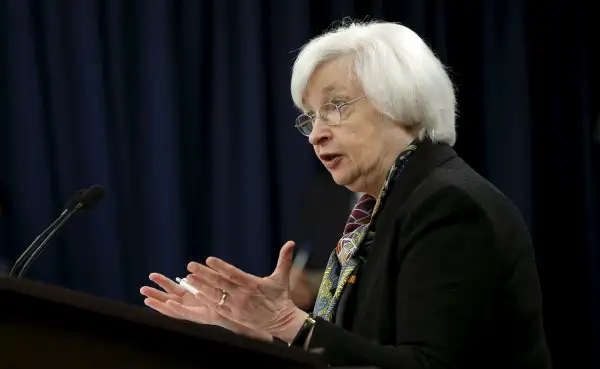Fed's Interest Rate Decision Shows the Central Bank is Trapped in a Box
Money is not a client of any investment adviser featured on this page. The information provided on this page is for educational purposes only and is not intended as investment advice. Money does not offer advisory services.

The U.S. economic recovery is so fragile right now that it cannot sustain another headwind.
That's essentially what the Federal Reserve said when it voted Wednesday to leave short-term interest rates at their historically low levels, in a move that was widely expected.
A rate hike was extremely unlikely this month given the sharp decline in job creation in May, weak domestic economic growth, and continued worries over events abroad. That includes a June 23 referendum in Great Britain that could have England leaving the European Union — a move that is likely to raise a host of new uncertainties about the global economy.
The Fed's decision to remain on hold, in theory, should keep the value of the U.S. dollar from rising, as low yields generally deter investors from parking their cash in a particular currency. And a flat or falling dollar is generally bullish for large U.S. companies, whose foreign sales are hurt whenever the dollar rises.
Yet the equation could change if Brits vote to leave the European Union, potentially creating chaos that could force international investors to flee the euro for the safer harbor of the dollar.
But that's for later.
For now, the Fed's commitment to ultra-low rates should keep the sluggish-but-advancing recovery going forward, as the current business cycle is lumbering into the start of its eighth year.
The focus now quickly turns to when the Fed might raise rates next.
"We think the Fed raises only one time this year," says John Stoltzfus, chief investment strategist for Oppenheimer Asset Management. "We'd be surprised if the Fed raises twice."
But will that be in late July, when the central bank meets next, or late September? Or will we have to wait until early November?
You've heard this story before. For the past few years, the central bank has been full of "Hamlet-on-the-Potomac" equivocations, with Fed officials hinting they'd like to increase rates from near historic lows, only to back away because of weak data or a global crisis just before a meeting.
Except for last December — when the Fed raised rates ever so slightly, from near zero to a range of between 0.25% and 0.5% — something always seems to get in the way.
Here's a look at where the economy really stands, and what challenges remain:
The Headwinds
The Fed has two priorities: to keep inflation steady and maximize employment. The past two jobs reports show there is still much work to be done on the latter. Employers added only 38,000 jobs in May, following 123,000 in April. Compare that to 271,000 new workers added last December.
Wages, meanwhile, still linger below pre-recession levels, only picking up 2.5% over the past 12 months, while inflation continues to rise below the Fed's 2% target. The labor force participation rate has also ticked down in recent months. And the economic growth disappointed in the first three months of the year, gaining only 0.8%.
- Calculator: What is my risk tolerance?
The bond market reflects a rather bleak outlook. The 10-year Treasury securities now pay just 1.61%, about half the yield from early 2014 levels. The appetite for bonds — which are coveted in a slow-growing environment free of inflation — seems insatiable (bond yields have an inverse relationship to bond prices).
In fact, this is the lowest point for borrowing rates in the past 5,000 years, according to Bank of America Merrill Lynch.
The Tailwinds
There's still reason for optimism. The unemployment rate rests at only 4.7%, household spending is strong, and oil has rebounded off of recent lows.
Retail sales grew more than expected in May, after outperforming in April, and have gained 2.5% over the past year. Core retail sales — which strips out cars, gasoline, building materials and food services — also proved strong, leading economists to believe that economic growth will pick up in the second three months of 2016.
"Overall, real GDP growth appears to have picked up to about a 2% pace in the second quarter following a 0.8% gain," notes JPMorgan Funds chief global strategist David Kelly.
If next month's jobs data proves improves, and there's no severe exogenous shock, the Fed will have to seriously consider raising rates in July "at least from a credibility standpoint," says co-portfolio manager of the BMO TCH Core Plus Bond Fund Scott Kimball.
The Verdict
All else being equal, the Fed seems inclined to increase rates. Stanley Fischer, the Fed's vice chair, started off the year by saying we could see three or four hikes this year, and you often hear Fed officials say something vaguely hawkish during press conferences and interviews.
But it looks as if the labor market has miles to go before investors will see another increase.
"My view is that the U.S. economy will continue to expand in the coming quarters," noted Russ Koesterich, head of asset allocation for BlackRock’s Global Allocation Fund. "Just don’t expect great things, or consistency."
